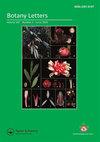The vegetation on ultramafic rocks in New Caledonia
IF 1.3
4区 生物学
Q3 PLANT SCIENCES
引用次数: 2
Abstract
New Caledonia, an archipelago in the Southwest Pacific, is a biodiversity hotspot (Myers 1988; Myers et al. 2000) whose rich and unique flora has generally been associated with the diversity of geological substrates. New Caledonia has one of the largest extent of ultramafic rocks in the world (Garnica-Díaz et al. 2023). Ultramafic rocks are igneous rocks that are poor in silicon and rich in iron and magnesium. When weathered, they produce soils that impose difficult conditions for plant growth (Kazakou et al. 2008), and they have often been referred to as “ultrabasic rocks” or “serpentine” in the literature. The peculiarity of New Caledonia was noted by its earliest European visitors. In his journal, James Cook wrote that “our botanists did not complain for want of employment at this place; every day bringing something new in botany or other branches of natural history” (Cook 1777, p. 124). Although they did not visit ultramafic outcrops, the naturalists accompanying James Cook were also struck by the geological distinctiveness of New Caledonia. For instance, Georg Forster (1777, p. 576) anticipated that “there was some probability of meeting with rich and useful minerals upon this island, which, as far as we saw, distinguished itself from all those we had hitherto examined in the South Seas, in being entirely destitute of volcanic productions”. Georges’ father, Johann Forster (1778, p. 34), similarly wrote that “the mountains of New Caledonia are the most likely to contain the richest metallic veins”. Later, the geologist Jules Garnier explored more extensively the main island of New Caledonia noting the large areas of “terrains serpentineux” (serpentine terrains) and revealing the abundance of nickel ores (Garnier 1885). This dramatically changed the future of the island where the mining industry now plays a major role. The earliest European naturalists exploring New Caledonia focused on inventorying the diverse flora of the archipelago, and had limited interest or time to study its ecology, including plant–soil relationships. Robert Virot made the first substantial contribution to the ecology of the New Caledonian flora with his thesis “La végétation canaque” (Virot 1956). After spending several years on the island, he was able to give an overview of the biological forms, plant formations, and phytosociology of the flora. His work prefigures that of Tanguy Jaffré. In 1980, Tanguy Jaffré published his PhD thesis entitled « Etude écologique du peuplement végétal des sols dérivés de roches ultrabasiques en NouvelleCalédonie » (« Ecological study of the plant population of soils derived from ultrabasic rocks in New Caledonia »). Although it was published in French by ORSTOM (now IRD) with limited dissemination, this work has attracted a large and steady number of citations over the years (Figure 1). With this in mind, we thought it would be useful to make this work more accessible to the scientific community as a whole. Thanks to the support of the Société Botanique de France, an English translation is published in this special issue. The three thesis chapters, « les formations végétales des terrains ultrabasiques » (“Plant formations on ultramafic rocks”), « les groupements végétaux des maquis » (“Plant communities of the maquis”), and « phytogéochimie » (“Plant mineral nutrition”) representing about 73% of the pages of the original text, are published as three articles in this special issue. The figures were reformatted and are published in colour for greater clarity. The plant taxonomy was updated following the FLORICAL database (Morat et al. 2012; Munzinger et al. 2023) and the soil classification follows the World Reference Base (IUSS Working Group WRB 2015). Minor alterations to the text were made to avoid anachronisms with the current state of the art on the ecology of ultramafic vegetation and the New Caledonian flora. The first article entitled “Plant formations on ultramafic rocks in New Caledonia” (Jaffré 2023a) starts with a description of three contact zones between ultramafic rocks and other substrates. These suture zones have received little attention since, although they are interesting systems to study. They are known as areas of micro-endemism (Pintaud and Hodel 1998; Pillon et al. 2008; Gâteblé and Munzinger 2018). There, species with distinct soil preferences can co-occur and hybridize, which may trigger speciation (Pillon et al. 2009). The second part of the article describes the main plant formations occurring on ultramafic rocks in New Caledonia. Contrary to many other areas in the world (particularly temperate regions), ultramafic substrates of New Caledonia can harbour dense and diverse forests. The forests of New Caledonia have received significant attention (e.g. Jaffré and Veillon 1995; Ibanez et al. 2014; Birnbaum et al. 2015). The article also mentions several cases of monodominant formations, where one tree species represents a large proportion of the individuals reaching the canopy. A wide diversity of species can be dominant in New Caledonia (Pillon et al. BOTANY LETTERS 2023, VOL. 170, NO. 3, 333–337 https://doi.org/10.1080/23818107.2023.2234432新喀里多尼亚超镁质岩石上的植被
新喀里多尼亚是西南太平洋的一个群岛,是生物多样性的热点(Myers 1988;Myers et al. 2000),其丰富而独特的植物群通常与地质基质的多样性有关。新喀里多尼亚拥有世界上最大范围的超镁质岩石之一(Garnica-Díaz et al. 2023)。超镁铁质岩石是一种缺乏硅而富含铁和镁的火成岩。风化后,它们产生的土壤对植物生长造成了困难的条件(Kazakou等人,2008),在文献中它们通常被称为“超基性岩”或“蛇形岩”。新喀里多尼亚的特点被最早的欧洲游客所注意到。詹姆斯·库克(James Cook)在他的日记中写道:“我们的植物学家没有抱怨在这个地方找不到工作;每天都在植物学或自然史的其他分支中带来新的东西”(库克1777,第124页)。虽然陪同詹姆斯·库克的博物学家们没有参观超镁铁的露头,但他们也被新喀里多尼亚独特的地质特征所震撼。例如,Georg Forster(1777,第576页)预测“在这个岛上有可能遇到丰富而有用的矿物,就我们所知,它与我们迄今为止在南海考察过的所有岛屿不同,完全没有火山产物”。乔治的父亲约翰·福斯特(1778,第34页)同样写道:“新喀里多尼亚的山脉最有可能含有最丰富的金属矿脉”。后来,地质学家朱尔斯·卡尼尔对新喀里多尼亚主岛进行了更广泛的探索,发现了大面积的“蛇形地形”,并发现了丰富的镍矿石(卡尼尔1885)。这极大地改变了该岛的未来,在这里,采矿业现在起着重要作用。最早探索新喀里多尼亚的欧洲博物学家专注于清点群岛上各种各样的植物群,对研究其生态,包括植物与土壤的关系,兴趣或时间都很有限。罗伯特·维罗对新喀里多尼亚植物区系的生态学作出了第一个实质性的贡献,他的论文是“La vacimacement canque”(维罗1956年)。在岛上呆了几年之后,他对植物的生物形态、植物形成和植物社会学进行了概述。他的作品预示着唐吉·贾夫瑞的作品。1980年,Tanguy jaffr<s:1>发表了他的博士论文,题目是“Etude <s:1> <s:1> <s:1> <s:1> <s:1> - - - - - - - - - - - - - - - - - - - -新喀里多尼亚超基性岩石土壤植物种群的生态学研究”。虽然它是由ORSTOM(现在的IRD)以法语出版的,传播有限,但这项工作多年来吸引了大量稳定的引用(图1)。考虑到这一点,我们认为让整个科学界更容易获得这项工作是有用的。在法国植物学会的支持下,本特刊出版了英文译本。论文的三个章节,“les formations vsamgsametales des terrains ultrabasiques”(“超镁质岩石上的植物构造”),“les groups vsamgsametaux des maquis”(“maquis的植物群落”)和“phytogsamochimie”(“植物矿物质营养”),占原始文本的73%,作为三篇文章发表在本期特刊上。为了更清晰,这些数据被重新格式化并以彩色发布。植物分类根据FLORICAL数据库更新(Morat et al. 2012;Munzinger et al. 2023),土壤分类遵循世界参考库(IUSS工作组WRB 2015)。为了避免与超热带植被生态学和新喀里多尼亚植物区系的最新技术状况不一致,对案文作了微小的修改。第一篇题为“新喀里多尼亚超镁质岩石上的植物构造”(jaffr<e:1> 2023a)的文章首先描述了超镁质岩石和其他基材之间的三个接触带。尽管这些缝合带是值得研究的有趣系统,但此后很少受到关注。它们被称为微特有区(Pintaud and Hodel 1998;Pillon et al. 2008;<s:1> tebl<s:1>和Munzinger 2018)。在那里,具有不同土壤偏好的物种可以共存并杂交,这可能引发物种形成(Pillon et al. 2009)。文章的第二部分描述了新喀里多尼亚超镁质岩上的主要植物构造。与世界上许多其他地区(特别是温带地区)相反,新喀里多尼亚的超基性基质可以孕育茂密多样的森林。新喀里多尼亚的森林得到了极大的关注(例如,jaffr<s:1>和Veillon, 1995年;Ibanez et al. 2014;Birnbaum et al. 2015)。 这篇文章还提到了几个单优势形成的例子,其中一个树种代表了到达树冠的大部分个体。新喀里多尼亚具有广泛的物种多样性(Pillon等)。《植物学通讯》2023卷170号。3,333 - 337 https://doi.org/10.1080/23818107.2023.2234432
本文章由计算机程序翻译,如有差异,请以英文原文为准。
求助全文
约1分钟内获得全文
求助全文
来源期刊

Botany Letters
Agricultural and Biological Sciences-Plant Science
CiteScore
3.10
自引率
6.70%
发文量
54
期刊介绍:
Botany Letters is an international scientific journal, published by the French Botanical Society (Société botanique de France) in partnership with Taylor & Francis. Botany Letters replaces Acta Botanica Gallica, which was created in 1993, building on over a century of renowned publications by the Société botanique de France.
 求助内容:
求助内容: 应助结果提醒方式:
应助结果提醒方式:


